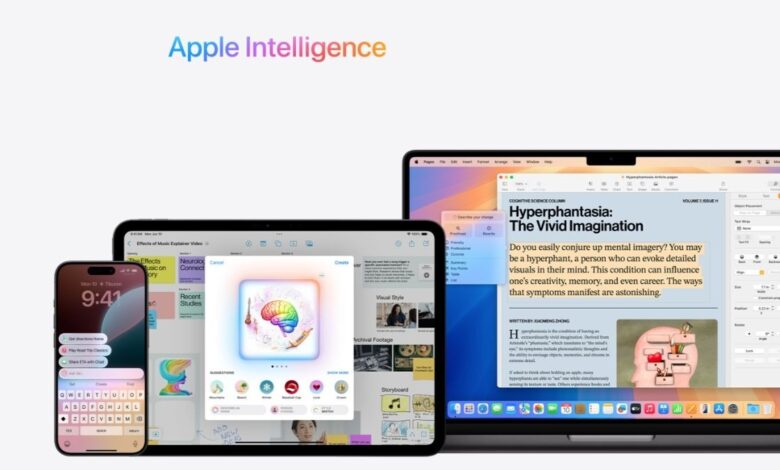In this WWDC 2024: Apple Intelligence is generative AI for iPhone, Mac and iPad and it is different from ChatGPT

Those who keep an eye on Apple know it well: The company doesn’t care much about being first with technology. Instead, even when it is not first, it tends to offer technology that is unique and implemented relatively different from how the rest of the world is doing it. The latest example of that: Apple Intelligence that the company unveiled at WWDC 2024.
But before that, a quick history lesson. Do you know who introduced the first touchscreen smartphone? You may say Apple, but that is not accurate. It was IBM that introduced the Simon phone in 1994. The Simon was a big tech leap. We got to see how the device would be controlled by direct tapping on the display. But Simon didn’t start the era of touchscreen phones. That had to wait until the iPhone appeared on the scene in 2007. The iPhone was smarter and better. Apple used old tech – touch screen – but used it in a way that was unique and kickstarter something new.
It is possible that the arrival of Apple Intelligence may mark a similar moment for generative AI. This is because even though on surface the Apple Intelligence seems similar to OpenAI ChatGPT and Google Gemini, apparently it is doing things differently. And by doing things differently, Apple is showing how the AI can be simple, powerful and private.
And to understand, let’s look below the surface.
Apple Intelligence is personal AI
By now we know how to use ChatGPT and how it works in terms of user interface. There is an app, the new GPT-4o has a voice assistant to help, Dall-E creates images and so on. So, to use the AI we know we can just open these apps or websites to get the things done with text prompts or voice commands.
However, with the introduction of Apple Intelligence, Apple is showing a difference. It is integrating AI inside its iPhone and Mac and iPad in a more fundamental way. This means there is not going to be a separate Apple Intelligence app – although in a way revamped Siri is that – but the AI features and tools will be available across different apps. For instance while writing in mail, iMessages or Pages users will summon AI whenever they need it. Similarly, the Apple AI will keep track of a lot of your data – say daily tidbits such as date of your next flight or an entry in your calendar or a a reminder or someone’s request in your messages – and then tie it up in one place to offer this information to you when it is required. So you will be able to ask “what time is my flight” and your iPhone will answer.
All in all Apple Intelligence is kind of a new brain in supported Apple devices that can follow the user interactions or allow them to control their devices in a whole new smarter way. And instead of introducing a whole new platform to use AI like ChatGPT, Apple just decided to integrate AI within the apps that are already used by millions of people.
At the same time, to use AI chatbots like ChatGPT and to get the job right, you have to give prompts. However, framing the prompts is not easy-peasy for everyone, and with confusing prompts, these AI chatbots can throw out all kinds of rubbish. Apple Intelligence aims to simplify this. With just a few words, images, and one-word prompts, the Apple AI would understand user needs. So instead of those long prompts for ChatGPT, Apple’s AI cuts down on prompts for quick and easy tasks.
The privacy we were looking for
OpenAI and companies like Google, Meta, and others have been using user data and prompts from chatbots to train their AI models. This step has definitely raised concerns over privacy among users. It eventually became the notion that to get help from AI, you would have to compromise your privacy. However, with Apple Intelligence, Apple has finally brought on-device processing. With its chips like A17 Pro, M1, M2, M3, and M4, Apple says that its AI will use on-device processing to generate its responses.
And when it requires more power, it will rely on a “private cloud computing” system that Apple has specifically created for Apple Intelligence. This system – Apple calls it Private Compute – will ensure that not even Apple saves or accesses the user data. Only the device – iPhone or Mac on which you are trying to use Apple Intelligence – will connect to the Private Compute and the data sharing between two machines will be entirely encrypted and will happen in absolute privacy.
External help but only if you give consent to it
Yes, ChatGPT is going to be part of the Apple Intelligence system. But Apple is saying that most of the AI functionality will be powered by its own large language model and not by ChatGPT. Yet, if you need to use ChatGPT users will be able to access it. But when you do, Apple will explicitly ask for user consent before offloading the AI task to ChatGPT. So if you need help from ChatGPT while writing or using Siri, Apple Intelligence will suggest that ChatGPT can help but only if you say yes to it.



